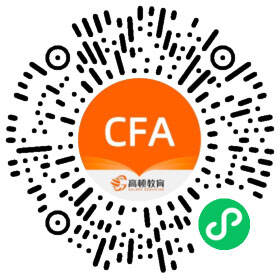

1、凡本网站注明“来源高顿教育”或“来源高顿网校”或“来源高顿”,的所有作品,均为本网站合法拥有版权的作品,未经本网站授权,任何媒体、网站、个人不得转载、链接、转帖或以其他方式使用。
2、经本网站合法授权的,应在授权范围内使用,且使用时必须注明“来源高顿网校”或“来源高顿”,并不得对作品中出现的“高顿”字样进行删减、替换等。违反上述声明者,本网站将依法追究其法律责任。
3、本网站的部分资料转载自互联网,均尽力标明作者和出处。本网站转载的目的在于传递更多信息,并不意味着赞同其观点或证实其描述,本网站不对其真实性负责。
4、如您认为本网站刊载作品涉及版权等问题,请与本网站联系(邮箱fawu@gaodun.com,电话:021-31587497),本网站核实确认后会尽快予以处理。
2024年金融分析师培训哪个机构比较好?有准备报考2024年CFA考试的小伙伴咨询到学姐关于金融分析师哪个机构比较好这个问题,今天学姐就来详细的为大家进...
2023-11-082024年cfa培训哪个机构比较好?最近有准备报考24年CFA证书的小伙伴有些疑问,关于24年CFA考试如何选择培训班一事儿不知道怎么选择开始疑虑,今天小编就...
2023-11-072024年金融分析师培训一般都是多少钱?最近有准备报考2024年CFA考试的小伙伴咨询到学姐这个问题,今天小编就来详细的为大家进行解答,下面请跟随小编一...
2023-11-072024年金融分析师培训一般要多少钱?最近有准备报考2024年CFA考试的小伙伴咨询到学姐这个问题,今天小编就来详细的为大家进行解答,一起看看吧~...
2023-11-072024年武汉cfa培训机构哪个好,最近有小伙伴问到学姐这个问题,今天学姐就来统一为大家进行解答,下面请跟随学姐一起来看看吧~ ...
2023-11-062024年天津金融分析师辅导机构哪个好,最近有小伙伴问到学姐这个问题,今天学姐就来统一为大家进行解答,下面请跟随学姐一起来看看吧~ ...
2023-11-062024年天津cfa分析师培训机构哪个好,最近有小伙伴问到学姐这个问题,今天学姐就来统一为大家进行解答,下面请跟随学姐一起来看看吧~ ...
2023-11-062024年广州金融分析师辅导机构哪家好?准备报考2024年广州CFA考试的小伙伴看过来,今天学姐就来详细的进行说明,一起来看看吧~ ...
2023-11-06老师 为什么第二题不做处理呢 不应该计入资本公积—股本溢价吗
老师好,这道题的会计分录应该是这样的吧,但是我不理解其他综合收益2000那个步骤,他不是以摊余成本计量的金融资产已确认损失2000万吗?不应该是信用减值损失的科目吗?为什么写其他综合收益这个科目在这里?
老师您好,固定资产清理,卖掉时候,转银行存款和资产处置损益,差别在哪里呢。我觉得卖掉固定资产,转哪个都差不多啊,谢谢老师。
选项c,资本公积—股本溢价4500为什么不选?
收回前期已核销的坏账,坏账准备记录在贷方怎么理解
老师 为什么第二题不做处理呢 不应该计入资本公积—股本溢价吗
老师好,这道题的会计分录应该是这样的吧,但是我不理解其他综合收益2000那个步骤,他不是以摊余成本计量的金融资产已确认损失2000万吗?不应该是信用减值损失的科目吗?为什么写其他综合收益这个科目在这里?
老师您好,固定资产清理,卖掉时候,转银行存款和资产处置损益,差别在哪里呢。我觉得卖掉固定资产,转哪个都差不多啊,谢谢老师。
选项c,资本公积—股本溢价4500为什么不选?
收回前期已核销的坏账,坏账准备记录在贷方怎么理解
2024年cfa培训班一般都是多少钱?最近有小伙伴咨询到学姐这个问题,今天小编就来详细的为大家进行解答,一起来看看吧~...
2023-10-31What is the appointment process for the 2024 CFA exam? Today, my senior student will come and tell everyone about this matter. Let's take a look together~...
2023-10-13CFA,中文名称为特许金融分析师,在金融界称之为“金融第一考”,相比起其它金融类考试,CFA是存在一定难度的,所以在考试中我们有什么小技巧呢,今天学姐就来跟大家讲讲关于CFA的学习技巧小妙招,感兴趣的小伙伴请接着往下看~...
2023-08-16CFA,特许金融分析师考试在国际金融界称之为“金融第一考”,今天小编就来好好为大家介绍一下关于CFA的学习方法小妙招,感兴趣的同学们请接着往下看吧~...
2023-08-15由于许多同学都是第一次考CFA,对于考试的难度不是很了解。今天学姐就来详细的为大家介绍一下CFA考试的三个级别的难点分别在哪,以及如何攻克这些难点,一起来看看吧~...
2023-08-10八月CFA报名考试即将开始,有不少同学没赶上,只能参加11月份的,那么11月CFA备考攻略有哪些呢,今天学姐就来好好跟大家讲讲这件事儿,一起来看看吧~...
2023-08-09cfa考试可以取消吗?取消会不会退报名费?2023年11月CFA考试正在报名中,不少想要报名考试的考友也完成了报名工作,但是考生在完成考试预约之后,发现个人没有时间参加考试,咨询cfa考试可以取消吗,下面就来进行详细解答。...
2023-08-07CFA作为全球金融领域备受认可的资格证书之一,也受到更大公司和企业的青睐,那么CFA证书的职业发展前景如何呢?拥有CFA证书的就业优势有哪些呢?今天学姐就来带领大家一起看看究竟怎么一回事儿吧~...
2023-08-01CFA考试一共包括十个科目,其中一级考试的考试内容就包括这十个科目,对于很多考试而言都是讲究科目的复习顺序的,因此就有考生想要知道CFA一级考试讲究复习顺序吗?当然是需要的,考生不应该胡乱复习。同时对于考生而言制定学习计划也是很重要的事情,那么如何制定复习计划呢?如果你也对此感.........
2023-07-19